Wednesday, August 13
August 13, 2008
Yesterday at Sagalassos in Turkey, archaeologists uncovered the colossal portrait head of the Roman empress Faustina, wife of the emperor Antoninus Pius, who ruled from A.D. 138 to 161.
Scholars and soldiers continue to monitor archaeological sites in Iraq. In June, a team of archaeologists visited eight sites with the British Army. “I was reasonably encouraged by what I saw at the limited number of sites,” said Elizabeth Stone of Stony Brook University in New York. This article on the scholars’ tour of Iraq emphasizes the damage done by military activity and neglect, and the looting that is taking place out of sight of coalition bases. “The lack of resources for the Iraqi Department of Antiquities means they simply haven’t been able to inspect the sites or do conservation or restoration work,” said Paul Collins of the British Museum.
A skull found in the attic of a house in Tooele, Utah, has been radio carbon dated to between 1620 and 1800. State archaeologist Ron Rood thinks that the skull was probably taken from a cave. “It is a very unique and interesting specimen in the fact that it still had teeth and hair attached. Most skeletons don’t,” he said.
The bones of a carefully buried calf were uncovered in St. Augustine, Florida, while city archaeologist Carl Halbirt was looking for the Rosario Line, an earthen defensive wall that surrounded the city in the eighteenth century. “It doesn’t want to be found,” he said.
The construction of a private residence on the North Shore of Kauai, on a lot where at least 30 ancient Hawaiian burials have been identified, is still on hold. The builder, who has been camping out at the site with the protesters, claims that the locations of the burials in the treatment plan do not align on the ground with the burials marked on the building plans.
Here’s another article explaining what scientists have learned from the mapping of Neanderthal mitochondrial DNA.
- Comments Off on Wednesday, August 13
Tuesday, August 12
August 12, 2008
Four 8,000-year-old skeletons are the oldest so far to be unearthed during excavations for Istanbul’s new subway. The project has also uncovered 32 ships, and walls that may have been the first city walls of Istanbul.
The skull of a giant kangaroo found in Tasmania has been dated to 41,000 years ago, 2,000 years after humans are thought to have arrived on the island. “Up until now, people thought that the Tasmanian mega-fauna had actually gone extinct before people arrived on the island,” said Richard Roberts of the University of Wollongong. Did early hunters wipe out mega-fauna? Â
Yesterday marked the beginning of Egypt’s plan to keep peddlers away from the Giza pyramids with a security fence. “It was a zoo. Now we are protecting both the tourists and the ancient monuments,” said Zahi Hawass, general secretary of the Supreme Council of Antiquities. Â
Two sets of human remains were found beneath the floorboards of 400-year-old St. George’s Church in Bermuda. One of the skeletons is thought to have belonged to a British Naval commander who died of yellow fever in 1783. Â
A European woman’s skull found four years ago in New Zealand has been carbon dated to decades before Captain Cook arrived in 1769. “We’ve got the problem of how did this woman get here? Who was she?” asked forensic anthropologist Robin Watt. Â
National Geographic News has more information on the 2,500-year-old Greek ship raised off the southern coast of Gela, Sicily, last month. Â
Photographs of tumbled columns, and a coin bearing an image of a temple to Zeus and Tyche, are included in this BBC News article on the Roman temple discovered at Sepphoris.  Â
There’s more on the mapping of Neanderthal mitochondrial DNA in this article from The Independent. “What we’ve done is confirm that the mitochondrial DNA of Neanderthals and modern humans was so different that it forms powerful evidence that there was very little if any interbreeding between the two species,” said Adrian Briggs of the Max Planck Institute.
- Comments Off on Tuesday, August 12









